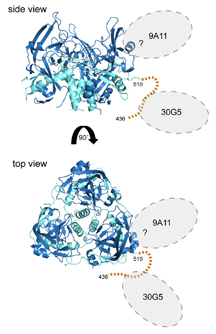Team Finds New Antibody Weapons against Marburg Virus
By Madeline McCurry-Schmidt
A new study led by scientists at The Scripps Research Institute (TSRI) and biotech partners identifies new immune molecules that protect against deadly Marburg virus, a relative of Ebola virus. The research provides ingredients needed to develop treatments for future Marburg outbreaks.
“These antibodies attack a new site on Marburg virus we had not seen before,” said Erica Ollmann Saphire, senior author of the new study, professor at TSRI and director of the Viral Hemorrhagic Fever Immunotherapeutic Consortium.
The new antibodies that identify and neutralize Marburg virus—which has a mortality rate of up to 90%—were developed through an academic-industrial partnership including TSRI, Integrated Biotherapeutics, Mapp Biopharmaceutical and Emergent BioSolutions. Currently, there are no vaccines or treatments specifically for Marburg infections.
The findings were published recently in the journal PloS Pathogens.
New Tools to Fight Marburg Virus
The new study builds on previous work in Saphire’s lab revealing a molecular structure that Marburg virus uses to attach to and enter host cells.
To defeat Marburg virus, scientists are looking for vulnerable sites on the virus’s surface where an antibody can bind. Previous research, including trials with the experimental ZMappTM treatment, shows that mixtures or “cocktails” of antibodies can block Ebola virus from infecting new cells and alert the immune system to the presence of the infection. It’s thought that a similar cocktail strategy could work against Marburg virus. Antibodies against one site on Marburg were revealed in a study by Vanderbilt University and TSRI in February 2015, but complementary antibodies needed against other sites remained to be discovered.
In the new study, TSRI researchers designed proteins which elicited new antibodies developed at Emergent BioSolutions. Other antibodies in the study were independently identified at Mapp Biopharmaceutical and Integrated Biotherapeutics, which collaborated with TSRI for molecular analysis.
Some of the new antibodies target a new site on Marburg virus not seen before—a wing-like feature attached to the base of the virus. Antibodies against this newly discovered site protected 90 to 100% of infected animal models from lethal infection.
Ebola Virus Also Vulnerable
Some antibodies discovered in the new study are also able to cross-react with Ebola virus and its four relatives in the Ebolavirus genus.
“We expect both Marburg virus and Ebola virus to emerge again and to acquire new mutations,” said TSRI Research Assistant Marnie Fusco, first author of the new study. “The cross-reactive antibodies could be used as diagnostics for newly emerging strains.”
“The high cost of creating independent vaccines or treatments for each of the different viruses in this family necessitates intelligent design of immunogens (antibody-inducing molecules). The molecular images used to design the molecules and evaluate the antibodies point the way forward,” added Jody Berry, the former Director of Pipeline Research of Emergent BioSolutions, who initiated the study with Saphire six years ago.
“Understanding where and how the antibodies interact with the virus tells us which regions can be targeted and helps us develop lead candidates for clinical development,” said Cory Nykiforuk, current director of pipeline research of Emergent BioSolutions. “There are multiple filoviruses that threaten our communities, front line medical workers and defense personnel, and bringing new technologies to the forefront could potentially help meet future requirements.”
In addition to Saphire, Fusco, Berry and Nykiforuk, authors of the study, “Protective mAbs and Cross-reactive mAbs Raised by Immunization with Engineered Marburg Virus GPs,” were Javad Aman, Kelly Warfield, Fredrick Holtsberg, Sergey Shulenin and Hong Vu of Integrated Biotherapeutics; Gene Olinger and Julia Biggins of USAMRIID and NIAID; Robyn Cassan of Emergent BioSolutions; Sheng Li of The University of California, San Diego; Andrew Ward, Takao Hashiguchi and Daniel Murin of TSRI; and Larry Zeitlin and Kevin Whaley of Mapp Biopharmaceutical. See http://www.plospathogens.org/article/metrics/info%3Adoi%2F10.1371%2Fjournal.ppat.1005016
This study was supported by the National Institutes of Health (NIH) National Institute of Allergy and Infectious Diseases (grants 5R01AI089498, 5U19AI109762, 1U01AI082156 and R43 AI082744), a predoctoral fellowship from the National Science Foundation, a postdoctoral fellowship from the Japan Society for Promotion of Science, the Uehara Memorial Foundation, and an Investigators in the Pathogenesis of Infectious Disease award from the Burroughs Wellcome Fund.
Send comments to: press[at]scripps.edu














